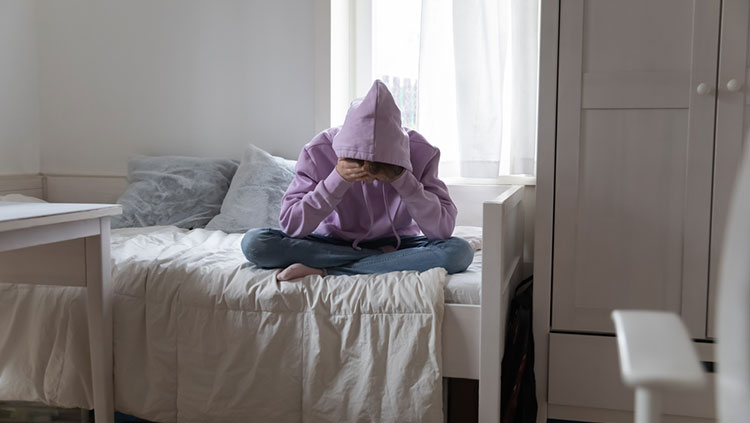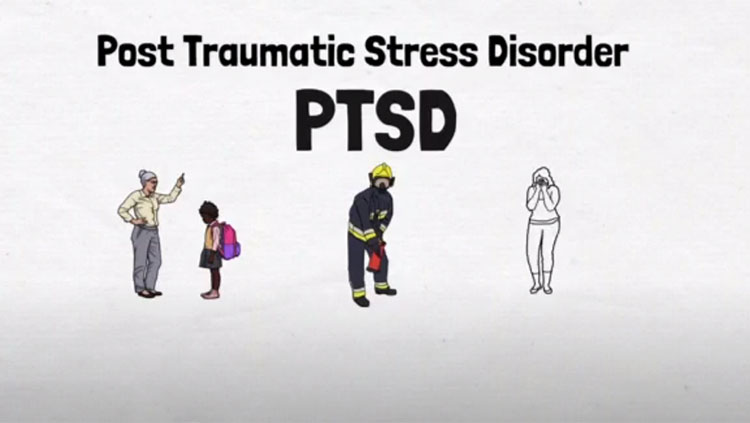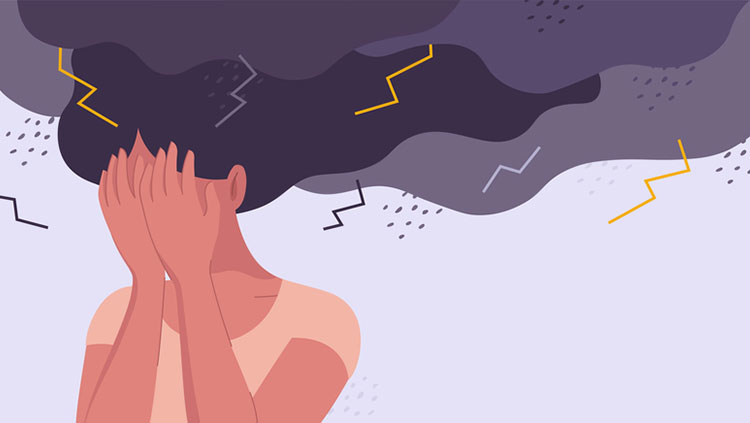The Broad Reach of PTSD
- Published17 Jan 2020
- Author Jessica P. Johnson
- Source BrainFacts/SfN
Historically associated with combat veterans, PTSD symptoms occur in people with vastly different experiences, including those whose jobs rarely take them away from a desk.
If you need immediate help for symptoms you are experiencing, contact your healthcare provider or VA clinic, or call the National Suicide Prevention Lifeline at 1-800-273-TALK, that’s 1-800-273-8255.
CONTENT PROVIDED BY
BrainFacts/SfN
Transcript
[BrainFacts.org]: In 2014, psychiatrists discovered evidence in 3,000-year-old texts that Mesopotamian soldiers experienced symptoms of post-traumatic stress disorder, or PTSD. Yet, PTSD was not officially recognized by the mental health profession until 1952 in the very first version of the go-to handbook for diagnosing mental disorders, called the Diagnostic and Statistical Manual of Mental Disorders. Since then, mental health professionals and neuroscientists have increasingly documented PTSD symptoms not just in combat veterans, but in people with vastly different experiences, including those whose jobs rarely take them away from a desk.
I’m Jessica Johnson for BrainFacts.org.
About one in five people who experience a threat of death or serious injury, such as during warfare, sexual assault, abuse, traffic accidents, natural disasters, or pregnancy-related trauma, will develop PTSD. But it can also affect those who merely hear about a friend or family member who experienced such an event, as well as eyewitnesses to traumatic events, such as first responders, health care professionals, rescue workers, or journalists covering combat zones.
And with the availability of violent images on the Internet, PTSD can even reach us through our screens. A February 2019 investigative report by The Verge describes symptoms of PTSD in some Facebook content moderators who must view violent videos and images for hours a day to identify and remove unacceptable content from the social media platform.
To be diagnosed with PTSD, a person must experience four types of symptoms that linger for at least one month and interfere with their normal daily life. These include intrusive memories of the event, such as flashbacks or nightmares; avoidance of things that remind them of the event; an increase in negative thoughts and emotions, including depression, isolation, and guilt; and changes in physical or emotional reactions to things, such as irritability and aggression, trouble sleeping or concentrating, being easily startled or fearful, and engaging in risky behavior.
Julia Rose: If you know five people who have PTSD, they’re not all going to manifest it in the same way. So, it really is getting to know each individual person to see what their unique triggers are and what their unique needs and supports are to be effective.
BF: That’s Julia Rose. She’s a Recovery Coordinator at the U.S. Department of Veterans Affairs in the Iowa City, Iowa, V.A. Health Care System who guides veterans with PTSD through individualized courses of treatment.
In the U.S., 5% of men will develop PTSD during their lifetime. The rate doubles for women at 10%, because they are more likely to experience the type of trauma that carries a high risk of PTSD — that is sexual assault or other physical violence. About 8% of people who served in the military will develop PTSD, but this number jumps to 30% for combat veterans. And among rape survivors, more than half will develop PTSD.
Other factors that increase a person’s risk of developing PTSD after a traumatic event include previous trauma, especially if it occurred repeatedly or early in life, a family history of PTSD, and a personal history of depression or anxiety.
Most people with PTSD, around 70%, repeatedly re-live the traumatic event each time they remember it. This triggers a rush of stress-response hormones, hyper-arousal, and a rapid heart rate as intense as during the original trauma.
JR: The challenge is when that doesn’t turn off because either our coping skills aren’t enough to work with it or the trauma exposure has been for such a long period of time our body doesn’t remember how to turn on the parasympathetic nervous system.
BF: A smaller number of people with PTSD react completely differently — they detach from the memory of the traumatic event, becoming emotionally numb and sometimes dissociating from reality as if watching themselves from outside their own body. But this detachment can spread into everyday life.
Ruth Lanius: I’m Ruth Lanius. I’m a professor of psychiatry at the University of Western Ontario. The second subtype is protective in a way because you detach yourself from the emotions, but there’s a significant cost to that. And the cost to that is that people stop feeling both positive and negative emotions. So, they often go through life like robots feeling emotionally dead, having difficulties having loving feelings towards their partner and their children.
BF: Lanius says that research has uncovered some interesting associations between these two PTSD subtypes and brain anatomy and connectivity.
RL: In the case where people have this hyper-arousal — too much emotional response to recalling their own traumatic memories — you often see decreased activation of the ventromedial prefrontal cortex, which is part of the front part of the brain that really has dense connections with the limbic system — the emotional part of the brain, including the amygdala. So, if you don’t have enough activation in the frontal cortex, it’s thought that this part of the brain can’t inhibit adequately the limbic system and the amygdala that’s driving this kind of hyper-arousal response, hyper-emotionality response. Now, in contrast, people who are emotionally detached, who don’t have a significant increase in heart rate, who are kind of numbed out, have out of body responses, they actually have too much activation in the prefrontal cortex, which is thought to lead to over-dampening of the limbic system including the amygdala.
BF: Some studies have also found that people with PTSD have different-sized amygdala or hippocampi than people without PTSD, but it’s unclear whether these differences are a cause or a result of trauma and PTSD. Other studies show that the brain’s vestibular system, which provides a sense of balance, can be dysfunctional in people with PTSD.
RL: What we’re finding is that really many, many brain systems throughout the brain seem to be involved by post-traumatic stress disorder, and so I think we really need to expand our understanding of post-traumatic stress and its pathophysiology — that includes the entire brain — and really use that to help us to develop new treatments.
BF: For example, she says…
RL: The default mode network is the major brain network that’s active when our brain is at rest. But this network is also critical in engaging in social interaction. What our group and others have found is that this network is actually profoundly disrupted in people with post-traumatic stress disorder.
BF: Lanius says that these disruptions appear to cause some people with PTSD to misunderstand social cues and to perceive direct eye contact with suspicion and defensiveness, both symptoms of PTSD. But research into new treatments offers hope…
RL: Neurofeedback is an exciting treatment that’s being tested. Neurofeedback is a form of biofeedback. And there you can help people retrain their brainwaves. And we know that, you know, the brain is not firing right in post-traumatic stress. And some preliminary evidence suggests that with neurofeedback you can normalize some of the major brain networks that are abnormal in post-traumatic stress.
BF: But there are already many well-established and successful treatments that provide relief to people with PTSD. Psychotherapies, including biofeedback, teach people to recognize and control their physical symptoms, to stop fearing and avoiding their memory triggers, to reframe negative thoughts, and to make sense of their memories and feelings about a traumatic event. Antidepressants and anti-anxiety drugs are also frequently used in combination with psychotherapy.
According to the National Center for PTSD, nearly half of people who receive either psychotherapy or medication or a combination eventually recover from PTSD. But recovery doesn’t necessarily mean a complete absence of symptoms, Rose says.
JR: I don’t necessarily think that being without symptoms is successful treatment. I think it’s a lot of times, “am I able to manage my symptoms effectively?”, which can be exhausting. It takes a lot of work to manage symptoms, but if I can do the things that I want to do in life and I don’t avoid them, or I’m not waking up, you know, dripping with sweat every night and feeling tired because of my symptoms, that is a success.
BF: Unfortunately, only about half of people who experience PTSD will ever seek help for it.
JR: I think there’s a stereotype that people are generally violent and that is not true. That is not what PTSD is by virtue of a diagnosis. The fear that surrounds it, I think, can create more stigma to getting treatment than the symptoms itself.
BF: So, what can people do to better support those with PTSD?
JR: I think we can’t expect the person that we knew before the trauma to be exactly the same. We have to allow to get to know certain aspects of that person again while still knowing that they’re that person that we can love and help. So, a lot of times I think it helps for people to get more educated on what PTSD is. It’s not something people can power through, it’s not like mind over matter. It’s an emotional dysregulation. And there is hope for it, but we all have to be okay with where we’re at right now and not wish for things to go faster than it is. And to make sure the family member is getting the support that they need in doing things that help them cope and ground so they can be present when they need to be.
RL: I think we really need to move to personalized treatment and really figure out what’s most appropriate for that individual and what does that individual prefer.
BF: Thanks for listening. You can find more information about the causes, symptoms, and treatments for PTSD at BrainFacts.org. If you need immediate help for symptoms you are experiencing, contact your healthcare provider or VA clinic, or call the National Suicide Prevention Lifeline at 1-800-273-TALK, that’s 1-800-273-8255.
References
Abdul-Hamid, W. K. & Hughes, J. H. (2014). Nothing new under the sun: post-traumatic stress disorders in the ancient world. Early Science Medicine, 19(6), 549–557. doi: 10.1163/15733823-00196p02.
Andreasen, N. C. (2010). Posttraumatic stress disorder: a history and a critique. Annals of the New York Academy of Sciences, 1208(1), 67–71. doi: 10.1111/j.1749-6632.2010.05699.x.
Brain & Behavior Research Foundation. (2015, May 15). Shrinkage in Brain Structure Linked to Severe PTSD Symptoms, Combat Exposure. Retrieved from https://www.bbrfoundation.org/content/shrinkage-brain-structure-linked-severe-ptsd-symptoms-combat-exposure.
Clark, L. (2015, January 26). Ancient Assyrian Soldiers Were Haunted by War, Too. Smithsonian.com. Retrieved from https://www.smithsonianmag.com/smart-news/ancient-assyrian-soldiers-were-haunted-war-too-180954022/.
Feiner, L. (2019, February 25). Facebook content moderators describe PTSD symptoms, drug use, report says. CNBC.com. Retrieved from https://www.nbcnews.com/tech/tech-news/facebook-content-moderators-describe-ptsd-symptoms-drug-use-n975746.
Mayo Clinic. (2018, July 6). Post-traumatic stress disorder (PTSD). Retrieved from https://www.mayoclinic.org/diseases-conditions/post-traumatic-stress-disorder/symptoms-causes/syc-20355967.
Morey, R. A., Gold, A. L., LaBar, K. S., Beall, S. K., Brown, V. M., Haswell, C. C., … Mid-Atlantic MIRECC Workgroup. (2012). Amygdala volume changes in posttraumatic stress disorder in a large case-controlled veterans group. Archives of General Psychiatry, 69(11), 1169–1178. doi: 10.1001/archgenpsychiatry.2012.50
PTSD and DSM-5 - PTSD: National Center for PTSD [General Information]. (n.d.). Retrieved from https://www.ptsd.va.gov/professional/treat/essentials/dsm5_ptsd.asp#four
Skogstad, M., Skorstad, M., Lie, A., Conradi, H. S., Heir, T., & Weisæth, L. (2013). Work-related post-traumatic stress disorder. Occupational Medicine, 63(3), 175–182. doi: 10.1093/occmed/kqt003
Also In Mental Health
Trending
Popular articles on BrainFacts.org


















